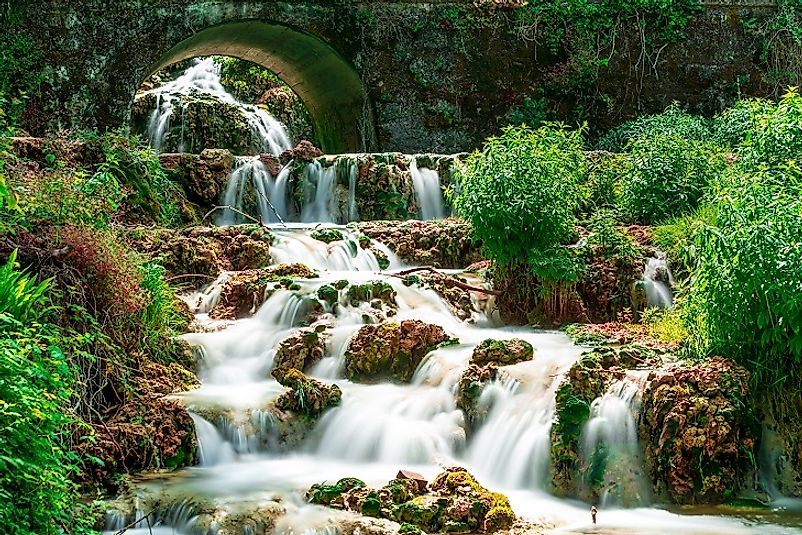Longest Rivers In Spain

Spain is a country in the southwestern edge of Europe, sharing the Iberian Peninsula with Portugal. The country covers an area of 195,363 square miles (505,990 square kilometers). The nation has an abundance of rivers that flow across its landscape. The rivers are useful in the generation of hydroelectric power, irrigation of land, and for promoting the fishing industry, among other uses. Some of the major rivers that flow across Spain are the Tagus, Ebro, Douro, Guadiana, Guadalquivir, Garonne, Jucar, Genil, Minh, and Segura.
Tagus
The Tagus is the longest river on the Iberian Peninsula. The river originates from Sierra de Albarracín in eastern Spain and flows westward through narrow valleys and deep canyons toward Portugal. It covers a total length of 645 miles and drains an area of 31,500 square miles. The Tagus forms part of the border between Spain and Portugal. It passes through several cities including the city of Lisbon in Portugal. River Tagus was useful in the development of Spain and Portugal. Cities such as Aranjuez, Toledo, and Talavera de la Reina developed on the banks of the Tagus. It is the primary source of water supply for the populations that live near the river. Additionally, dozens of hydro-power stations use its water to generate electricity. The river basin has an abundance of plants and animals. Trout, royal carp, black bass, and luce are some of the species found in the river. The Tagus basin supports Spanish vineyards. Coniferous trees used in the timber industry are also found on the Tagus basin.
Ebro
The Ebro is the longest river that is wholly in Spain, and the second longest in the Iberian Peninsula, covering 578 miles. Its source is the Fontibre springs in northern Spain. The river’s drainage basin covers an area of 33,000 square miles which is approximately a sixth of Spain’s land area. The Ebro flows towards the East and drains into the Mediterranean Sea. Over 200 tributaries pour into the Ebro. Some of the main tributaries are Gallego and Aragon Rivers. The Ebro supports Hydro-electric power stations that supply electricity to Spain. The river is also used in irrigating vineyards. Ebro basin is home to 95 bird species, 69 animal species, and nine plant species. The Fish in the Ebro have high mercury levels, and the European Union prohibits commercial fishing on the river. The eco-system of Ebro is threatened by construction of dams, chemical pollutants from factories, the introduction of invasive plants and animals, and agricultural dumping. The Ebro Delta National Park was created in 1986 as an effort to conserve the unique eco-system of Ebro.
Douro
The Douro is one of the major rivers in Spain, and is the third longest in the Iberian Peninsula. It covers a length of 557 miles as it flows across Spain and Portugal. Its origin is in the Sierra de Urbión in central Spain. It flows through the Numantian Plateau and continues westward through northern Portugal before draining into the Atlantic Ocean. Douro’s main tributaries are the Elsa, Arlanzón, and Pisuerga. The river has been used in hydro-electric power generation since 1930. Cultivation of olives and almonds occurs in the river basin. The Douro valley, famous for its vineyards, is a UNESCO World Heritage site. In the past, wine from the vineyards was transported through the river. Upstream, the river passes through gorges and rapids which make it hard to navigate but downstream in Portugal, and it is navigable. Many Spanish and Portuguese towns are built along the banks of Douro.
Guadiana
Guadiana is the fourth longest river in the Iberian Peninsula with a length of 508 miles. It originates in Castile-La Mancha in Spain and flows westwards to Portugal. Guadiana forms the border between Spain and Portugal in two sections. In Portugal, it flows south and drains into the Gulf of Cadiz. The river has over 30 dams constructed on the river basin. The dams are used for irrigation and hydro-electric power generation. The wetlands along the river are protected zones. Tourists frequently visit the areas of Ayamonte and Vila Real de Santo António where the river passes.
The Rivers that Shape the Spanish Nation
The landscape in Spain is marked by the major rivers that flow across the country. The rivers accommodate a wealth of plants and animals. They also offer scenic views to visitors. The rivers are of immense importance to the economy. Spanish authorities have established protected zones along the rivers to preserve the natural resources on the rivers.
The Longest Rivers In Spain
| Rank | Longest Rivers in Spain | Total Length |
|---|---|---|
| 1 | Tagus | 645 miles (shared with Portugal) |
| 2 | Ebro | 578 miles |
| 3 | Douro | 557 miles (shared with Portugal) |
| 4 | Guadiana | 508 miles (shared with Portugal) |
| 5 | Guadalquivir | 408 miles |
| 6 | Garonne | 374 miles (shared with France) |
| 7 | Jucar | 316 miles |
| 8 | Genil | 222 miles |
| 9 | Minho | 217 miles (shared with Portugal) |
| 10 | Segura | 202 miles |







